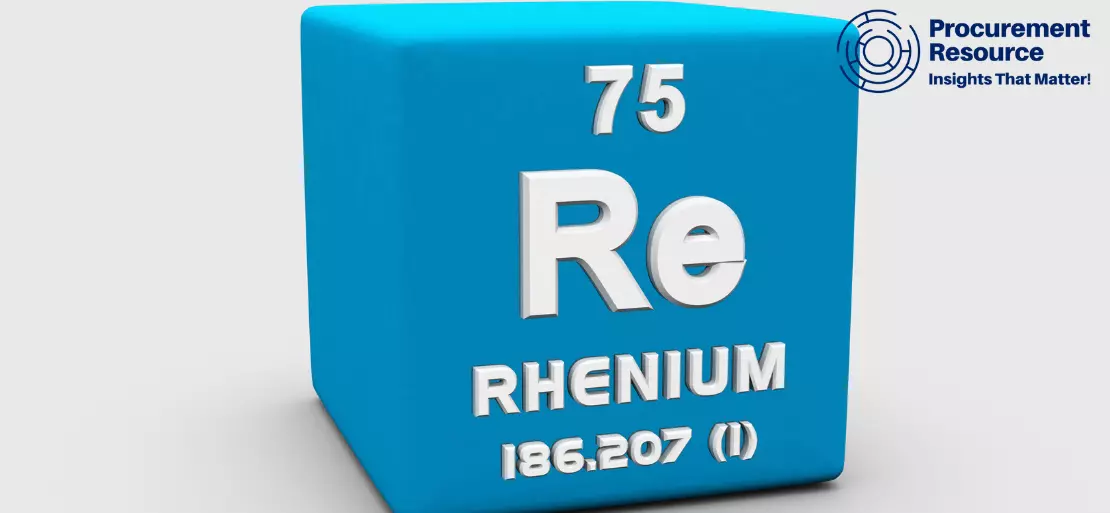Rhenium as a Crucial Metal for the High-tech Realm

Rhenium is the metallic counterpart of saffron (the extremely costly, luxurious, and rarest spice in the world) that has a crucial manufacturing of 60 t. With a thickness of 21 g/cm3, this converts the volume of it into lesser than 3 m3 or a realm of a thickness of a smaller amount than 2 m.
Request Access For Regular Price Update of Rhenium
This metal is found on the crust of the Earth in exceptionally scarce quantities, and it is noticed to appear organically only in a volcano in Sakhlain oblast region’s Kuril Islands based in Russia. It was in 1925 that rhenium was separated from the outer layer of Earth for the first time. Rhenium owns a spot in the middle of the intractable and noble metals in the periodic list of the elements.
Rhenium comes in the form of a metal which is highly strong, has great ductility with a cold operating property. This metal is utilised in various high temperature functions. Over 80 percent of the worldwide rhenium is used in high temperature high-class alloys for aircraft functionalities such as turbine blades and engine components. The rest of the demand for rhenium comes primarily from petrochemical refining sectors.
There are no key sources or traces of rhenium which is known; however, it is mined as a derivate from molybdenum distills, an offshoot of extracting copper ores. Rhenium has a third-highest melting point (followed by carbon and tungsten) as compared to other elements with 3186 °C. Besides, with a boiling point of 5627 °C, it takes the top rank in the list of metals.
Molybdenum-rhenium and tungsten-rhenium compounds were created during the early 1950s. Tungsten-rhenium alloys were first applied for industrial purposes that consisted of high-temperature thermocouples and vacuum tubes utilised in electronic machines.
For some time, rhenium was also employed to manufacture darts to completely impact aircraft properties, even though this application debatably utilises more of a tungsten alloy and a little quantity of rhenium.
With the use of rhenium, the alloy’s creep endurance is enhanced, leading to a sturdier element that guarantee fuel productivity at higher temperatures. This is an essential contribution toward lessening of fuel usage in the aerospace sector.
The second-best common use of rhenium is being employed as a catalyst. High-octane lead-free gasoline is manufactured by using platinum rhenium as a catalyst. In addition, rhenium is an essential metal required in the type of molybdenum-rhenium alloys in the aviation and electronics sectors to make ignition wires, semiconductors, filaments, electrical contacts, and reactors.
Molybdenum-tungsten-rhenium metals are essentially suitable to be used at an extremely high temperature as well as utilization that are subjected to high wear out. Furthermore, Tungsten-rhenium composites are also applied is the making of X-ray anodes required for high-resolution X-ray equipment, such as in angiography, computed tomography, and mammography.
Read More About Rhenium Production Cost Reports - REQUEST FREE SAMPLE COPY IN PDF
Notably, rhenium metal has a favourable bio compatibility property that makes it a desirable element to produce medical commodities such as implants.
Moreover, owing to their effective cellular incorporation and appealing photophysical qualities, Luminescent rhenium developments are being utilised in intracellular bio applications.
Scientist and inventors even today see excellent capability in rhenium to be used in potential upcoming applications as it is a comparatively young metal than the existing ones. Scientists have also studied the physical composition of rhenium diboride as an element for hard coatings and discovered that its solidity or toughness is nearly the same as that of cubic boron nitride.
About Author:
|
Prakhar Panchbhaiya Senior Content Writer at Procurement Resource Prakhar Panchbhaiya is an accomplished content writer and market research analyst. With over 4 years of experience in content creation and market analysis encompassing many industries, including pharmaceuticals, nutraceuticals, biochemistry, healthcare, ed-tech, and Food & Agriculture, he has been creating quality content for multiple sectors. He is a Biochemistry major with sturdy backing in a PG diploma in digital marketing, helping in the exhaustive content creation based on extensive research and competitive marketing. |

COMMENTS (0)